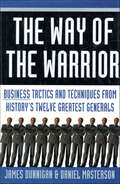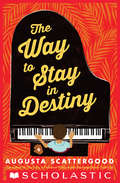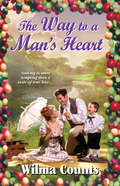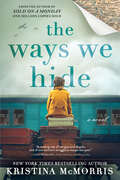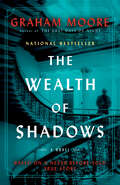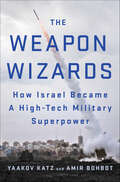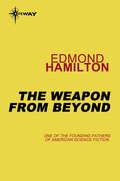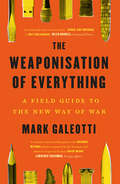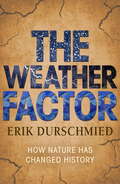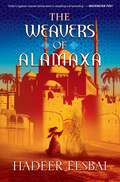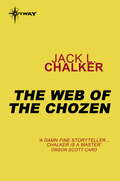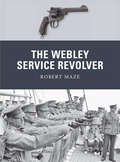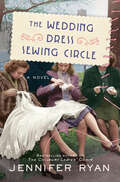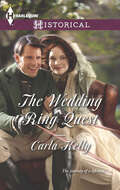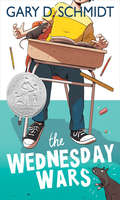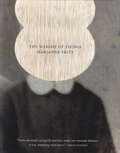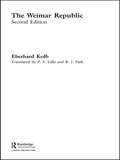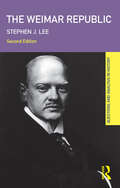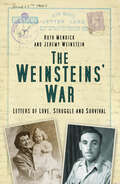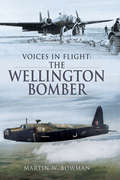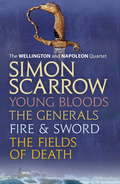- Table View
- List View
The Way of the Warrior
by Diane CareyThe entire Alpha Quadrant has been threatened with deadly infiltration by the shape-shifting Founders of the Dominion. Already the Romulans and Cardassians have been decimated by the clandestine machinations of the Founders. Now the newly promoted Captain Benjamin Sisko of Deep Space Nine has another problem: a massive fleet of Klingon warships has arrived at DS9 on a secret mission. Unable to learn anything from an elusive Klingon general, Sisko turns to Lt. Commander Worf, formerly of the Starship Enterprise and the only Klingon in Starfleet, to try and uncover the truth. What Worf learns will have a profound impact on the future of the Alpha Quadrant, and Sisko must risk destroying the Federation-Klingon alliance to prevent a full-scale war!
The Way of the Warrior: Business Tactics and Techniques from History's Twelve Greatest Generals
by Daniel Masterson James DunniganBusiness and war: both are forms of conflict, and both have more in common than people think. Business, like war, is the art of outdoing the competition. Businesses, like armies, need to practice strategic thinking and understand the nature of competitive conflict. CEOs devise business plans to win in the marketplace; generals use strategic thinking to win wars.In The Way of the Warrior James Dunnigan and Daniel Masterson reveal the management lessons of history's finest twelve military leaders, including: Alexander the Great, on having vision; Genghis Khan, on quick decisions; Julius Caesar, on communication; Napoleon, on managing change; Ulysses S. Grant, on the art of the turnaround; Douglas MacArthur, on coping with disaster; and Norman Schwarzkopf, on building alliances. The management hubris of these men is directly applicable in today's business world.Comprehensive, insightful, and extremely accessible, The Way of the Warrior won't show you how to call in air strikes on the competition, but it will show you how to be a manager who never loses his cool under fire.
The Way to Stay in Destiny
by Augusta ScattergoodFrom the author of the acclaimed GLORY BE, a novel that celebrates baseball, fast piano, and small-town living in the wake of the Vietnam War.When Theo gets off a bus in Destiny, Florida, he's left behind the only life he's ever known. Now he's got to live with Uncle Raymond, a Vietnam War vet and a loner who wants nothing to do with this long-lost nephew. Thank goodness for Miss Sister Grandersole's Boarding House and Dance School. The piano that sits in Miss Sister's dance hall calls to Theo. He can't wait to play those ivory keys. When Anabel arrives things get even more enticing. This feisty girl, a baseball fanatic, invites Theo on her quest to uncover the town's connection to old-time ball players rumored to have lived there years before. A mystery, an adventure, and a musical exploration unfold as this town called Destiny lives up to its name. Acclaimed author Augusta Scattergood has delivered a straight-to-the-heart story with unforgettable characters, humor, and hard questions about loss, family, and belonging.
The Way to a Man's Heart
by Wilma CountsA young woman disguises herself as a widowed cook and takes a job in the kitchen of a grumpy earl with delicious results in this Regency romance. After critiquing the poor fare at a soirée, Miss Nicole Beaufort&’s cousins wager her to do better. The daughter of an English noblewoman and a French chef, Nicole is confident she can win the challenge. But she will have to secure a position in a gentleman&’s kitchen—and keep it for at least six weeks . . . Disguising herself as a widowed cook, Nicole finds work at a nearby estate, where the health of her new employer depends on her pleasing his palate. Wounded at Waterloo, the handsome but ornery Earl of Thornwood refuses to eat. But while Nicole fully expects to tempt his appetite, she doesn&’t expect to tempt his heart as well . . . Includes delicious recipes for you to try!
The Way to a Soldier's Heart
by Gina WilkinsA family for her daughter? Elle O'Meara's happy being a single mom to her adopted two-year-old, Charlotte. Even so, when Shane Scanlon starts coming in to her bakeshop, he becomes a bright spot in her days. The handsome former army medic even strikes up a friendship with her daughter, making Elle wonder if there's room in her life for the excitement he could bring. Then Elle discovers why Shane's really there: he's Charlotte's biological uncle and wants her in his family. Elle prefers to believe he won't take Charlotte away, but he's already lied once. Now she doesn't know if her connection with Shane was real-or just another lie.
The Ways We Hide: A Novel
by Kristina McMorris"The Queen's Gambit meets The Alice Network in this epic, action-packed novel of family, loss, and one woman's journey to save all she holds dear—including freedom itself." —Kristin Harmel, New York Times bestselling author of The Forest of Vanishing StarsFrom the New York Times bestselling author of Sold on a Monday—over a million copies sold—comes a sweeping World War II tale of an illusionist whose recruitment by British intelligence sets her on a perilous, heartrending path.As a little girl raised amid the hardships of Michigan's Copper Country, Fenna Vos learned to focus on her own survival. That ability sustains her even now as the Second World War rages in faraway countries. Though she performs onstage as the assistant to an unruly escape artist, behind the curtain she's the mastermind of their act. Ultimately, controlling her surroundings and eluding traps of every kind helps her keep a lingering trauma at bay.Yet for all her planning, Fenna doesn't foresee being called upon by British military intelligence. Tasked with designing escape aids to thwart the Germans, MI9 seeks those with specialized skills for a war nearing its breaking point. Fenna reluctantly joins the unconventional team as an inventor. But when a test of her loyalty draws her deep into the fray, she discovers no mission is more treacherous than escaping one's past. Inspired by stunning true accounts, The Ways We Hide is a gripping story of love and loss, the wars we fight—on the battlefields and within ourselves—and the courage found in unexpected places.
The Wealth of Shadows: A Novel
by Graham MooreNATIONAL BESTSELLER • &“A thriller of a different kind—with an unlikely band of economists and bureaucrats working in the shadows to save the world.&”—Charles Frazier, New York Times bestselling author of Cold MountainAn ordinary man joins a secret mission to bring down the Nazi war machine by crashing their economy in this thrilling novel based on a true story, from the Academy Award–winning screenwriter of The Imitation Game and bestselling author of The Last Days of Night.1939. Ansel Luxford has everything a person could want—a comfortable career, a brilliant spouse, a beautiful new baby. But he is obsessed by a belief that Europe is on the precipice of a war that will grow to consume the world. The United States is officially proclaiming neutrality in any foreign conflict, but when Ansel is offered an opportunity to move to Washington, D.C., to join a clandestine project within the Treasury Department that is working to undermine Nazi Germany, he uproots his family overnight and takes on the challenge of a lifetime.How can they defeat the enemy without firing a bullet?To thwart the Nazis, Ansel and his team invent a powerful new theater of battle: economic warfare. Money is a dangerous weapon, and Ansel&’s efforts will plunge him into a world full of peril and deceit. He will crisscross the globe to broker backroom deals, undertake daring heists, and spar with titans of industry like J.P. Morgan and the century&’s greatest economic mind, Britain&’s John Maynard Keynes. When Ansel&’s wife takes a job with the FBI to hunt for spies within the government, the need for subterfuge extends to the home front. And Ansel discovers that he might be closer to those spies than he could ever imagine.The Wealth of Shadows is a mind-expanding historical novel about the mysterious powers of money, the lies worth telling to defeat evil, and a hidden war that shaped the modern world.
The Weapon Wizards: How Israel Became A High-Tech Military Superpower
by Amir Bohbot Yaakov Katz"A lively account of Israel's evolving military prowess...if The Weapon Wizards were a novel, it would be one written by Horatio Alger; if it were a biblical allegory, it would be the story of David and Goliath." —The New York Times Book ReviewFrom drones to satellites, missile defense systems to cyber warfare, Israel is leading the world when it comes to new technology being deployed on the modern battlefield. The Weapon Wizards shows how this tiny nation of 8 million learned to adapt to the changes in warfare and in the defense industry and become the new prototype of a 21st century superpower, not in size, but rather in innovation and efficiency—and as a result of its long war experience. Sitting on the front lines of how wars are fought in the 21st century, Israel has developed in its arms trade new weapons and retrofitted old ones so they remain effective, relevant, and deadly on a constantly-changing battlefield. While other countries begin to prepare for these challenges, they are looking to Israel—and specifically its weapons—for guidance. Israel is, in effect, a laboratory for the rest of the world. How did Israel do it? And what are the military and geopolitical implications of these developments? These are some of the key questions Yaakov Katz and Amir Bohbot address. Drawing on a vast amount of research, and unparalleled access to the Israeli defense establishment, this book is a report directly from the front lines.
The Weapon from Beyond
by Edmond HamiltonMorgan Chane was an Earthman by parentage, but he had been born on the pirate-world Varna, whose heavy gravity had developed strength and incredibly quick reflexes in him. When he was old enough, he joined the raider-ships that looted the starworlds, and fought side by side with the dreaded Starwolves of Varna. But then there was a fight among them. Chane killed their leader, and the other Starwolves turned on him. He barely got away alive - wounded near death, his Starwolf pursuers following him across the galaxy. And there was nowhere he could seek refuge, for no world would lift a hand to save one of the hated Starwolves.
The Weaponisation of Everything: A Field Guide to the New Way of War
by Mark GaleottiAn engaging guide to the various ways in which war is now waged—and how to adapt to this new reality Hybrid War, Grey Zone Warfare, Unrestricted War: today, traditional conflict—fought with guns, bombs, and drones—has become too expensive to wage, too unpopular at home, and too difficult to manage. In an age when America threatens Europe with sanctions, and when China spends billions buying influence abroad, the world is heading for a new era of permanent low-level conflict, often unnoticed, undeclared, and unending. Transnational crime expert Mark Galeotti provides a comprehensive and ground-breaking survey of the new way of war. Ranging across the globe, Galeotti shows how today&’s conflicts are fought with everything from disinformation and espionage to crime and subversion, leading to instability within countries and a legitimacy crisis across the globe. But rather than suggest that we hope for a return to a bygone era of &“stable&” warfare, Galeotti details ways of surviving, adapting, and taking advantage of the opportunities presented by this new reality.
The Weather Factor: How Nature Has Changed History
by Erik DurschmiedThroughout history, natural elements have been responsible for the deaths of more people than the spear, bullet or atomic bomb. Floods have drowned millions, droughts and famines wiped out entire populations, frost has halted invincible armies, and storms have sunk unsinkable fleets.When facing the weather, its unpredictability can lead to incredible disasters. Though we have made major advancements in collecting and forecasting the weather, huge seas, skies, rain-falls and freezes have confounded us since the days when Noah was forced to take to the Ark.Erik Durschmied uses his formidable knowledge of military strategy and his skill at human observation to give examples of how man can never prepare for the unexpected.
The Weather Factor: How Nature Has Changed History
by Erik DurschmiedThroughout history, natural elements have been responsible for the deaths of more people than the spear, bullet or atomic bomb. Floods have drowned millions, droughts and famines wiped out entire populations, frost has halted invincible armies, and storms have sunk unsinkable fleets.When facing the weather, its unpredictability can lead to incredible disasters. Though we have made major advancements in collecting and forecasting the weather, huge seas, skies, rain-falls and freezes have confounded us since the days when Noah was forced to take to the Ark.Erik Durschmied uses his formidable knowledge of military strategy and his skill at human observation to give examples of how man can never prepare for the unexpected.
The Weavers of Alamaxa: A Novel (The Alamaxa Duology #2)
by Hadeer ElsbaiFollowing up on one of the most exciting fantasy debuts, The Daughters of Izdihar, Hadeer Elsbai concludes her Alamaxa Duology—inspired by Egyptian history and myth—with a tale of magic, war, betrayal, sisterhood, and love.The world is on fire...but some women can control it.The Daughters of Izdihar—a group of women fighting for the vote and against the patriarchal rule of Parliament—have finally made strides in having their voices heard...only to find them drowned out by the cannons of the fundamentalist Ziranis. As long as Alamaxa continues to allow for the elemental magic of the weavers—and insist on allowing an academy to teach such things—the Zirani will stop at nothing to end what they perceive is a threat to not only their way of life, but the entire world.Two such weavers, Nehal and Giorgina, had come together despite their differences to grow both their political and weaving power. But after the attack, Nehal wakes up in a Zirani prison, and Giorgina is on the run in her besieged city. If they can reunite again, they can rally Alamaxa to fight off the encroaching Zirani threat. Yet with so much in their way—including a contingent of Zirani insurgents with their own ideas about rebellion—this will be no easy task.And the last time a weaver fought back, the whole world was shattered.Two incredible women are all that stands before an entire army. But they’ve fought against power before and won. This time, though, it’s no longer about rhetoric.This time it’s about magic and blood.
The Web of the Chozen
by Jack L. ChalkerNobody beats Bar Holliday.He was paid to find the Terraformable worlds, new planets for his corporation to plunder. Up until the day he came upon Peace Victory, an abandoned generation ship hovering ominously above a definitely habitable planet, he believed nobody ever could.Nobody beats Bar Holliday....because he was never satisfied with anything lower than first place, because he was always the oddball, in charge of his own welfare, his own destiny...a man determined to make his mark in the world and win games at any cost.NOBODY EVER BEATS BAR HOLLIDAY....because he only took the wrong chances at the right times. But on the planet Patmos, where everything looked safe, but nothing was, Bar Holliday had at last met his match!
The Webley Service Revolver
by Peter Dennis Robert MazeThe Webley .455in service revolver is among the most powerful top-break revolvers ever produced and has a claim to be the first 'tactical fighting pistol'. First adopted in 1887, in various marques it was the standard-issue service pistol for British and Commonwealth armed forces for nearly fifty years; later versions in .38in calibre went on to see further service in World War II and beyond, as well as in a host of law-enforcement roles around the world into the 1970s.Developed to give British service personnel the ability to incapacitate their opponents in 'small wars' around the globe, the Webley used the formidable - and controversial - .455in cartridge, a variant of which was known as the 'manstopper'. Users found it offered good penetration and excellent stopping power with only mild recoil - indeed, it was rated superior to the US .45 Colt in stopping power.Featuring specially commissioned full-colour artwork and close-up photographs, this is the compelling story of the Webley revolver, the powerful pistol that saw service across the British Empire and throughout two world wars.
The Wedding Dress Sewing Circle: A Novel
by Jennifer RyanThree plucky women lift the spirits of home-front brides in wartime Britain, where clothes rationing leaves little opportunity for pomp or celebration—even at weddings—in this heartwarming novel based on true events, from the bestselling author of The Chilbury Ladies&’ Choir.After renowned fashion designer Cressida Westcott loses both her home and her design house in the London Blitz, she has nowhere to go but the family manor house she fled decades ago. Praying that her niece and nephew will be more hospitable than her brother had been, she arrives with nothing but the clothes she stands in, at a loss as to how to rebuild her business while staying in a quaint country village.Her niece, Violet Westcott, is thrilled that her famous aunt is coming to stay—the village has been interminably dull with all the men off fighting. But just as Cressida arrives, so does Violet&’s conscription letter. It couldn&’t have come at a worse time; how will she ever find a suitably aristocratic husband if she has to spend her days wearing a frumpy uniform and doing war work?Meanwhile, the local vicar&’s daughter, Grace Carlisle, is trying in vain to repair her mother&’s gown, her only chance of a white wedding. When Cressida Westcott appears at the local Sewing Circle meeting, Grace asks for her help—but Cressida has much more to teach the ladies than just simple sewing skills.Before long, Cressida&’s spirit and ambition galvanizes the village group into action, and they find themselves mending wedding dresses not only for local brides, but for brides across the country. And as the women dedicate themselves to helping others celebrate love, they might even manage to find it for themselves.
The Wedding Ring Quest
by Carla KellyRITA Award–Winning Author: Searching all over Scotland for a ring gone astray, they may find something even more valuable . . . Penniless Mary Rennie knows she’s lucky to have a home with relatives in Edinburgh, but she does crave more excitement in her life. So when her cousin’s ring is lost in one of several fruitcakes heading around the country as gifts, Mary seizes the chance for adventure.When widowed captain Ross Rennie and his son meet Mary in a coaching inn, they take her under their wing. After years of battling Napoleon, Ross’s soul is war weary, but Mary’s warmth and humor touch him deep inside. Soon, he’s in the most heart-stopping situation of his life—considering a wedding-ring quest of his own! “Kelly has the rare ability to create realistic yet sympathetic characters that linger in the mind.” —Library Journal
The Wednesday Wars
by Gary D. SchmidtIn this Newbery Honor-winning novel, Gary D. Schmidt offers an unforgettable antihero. The Wednesday Wars is a wonderfully witty and compelling story about a teenage boy’s mishaps and adventures over the course of the 1967–68 school year in Long Island, New York.<P><P> Meet Holling Hoodhood, a seventh-grader at Camillo Junior High, who must spend Wednesday afternoons with his teacher, Mrs. Baker, while the rest of the class has religious instruction. Mrs. Baker doesn’t like Holling—he’s sure of it. Why else would she make him read the plays of William Shakespeare outside class? But everyone has bigger things to worry about, like Vietnam. His father wants Holling and his sister to be on their best behavior: the success of his business depends on it. But how can Holling stay out of trouble when he has so much to contend with? A bully demanding cream puffs; angry rats; and a baseball hero signing autographs the very same night Holling has to appear in a play in yellow tights! As fate sneaks up on him again and again, Holling finds Motivation—the Big M—in the most unexpected places and musters up the courage to embrace his destiny, in spite of himself.
The Wehrmacht: History, Myth, Reality
by Wolfram WetteThis book is a profound reexamination of the role of the German army, the Wehrmacht, in World War II. Until very recently, the standard story avowed that the ordinary German soldier in World War II was a good soldier, distinct from Hitler's rapacious SS troops, and not an accomplice to the massacres of civilians. Wolfram Wette, a preeminent German military historian, explodes the myth of a "clean" Wehrmacht with devastating clarity. This book reveals the Wehrmacht's long-standing prejudices against Jews, Slavs, and Bolsheviks, beliefs that predated the prophecies of Mein Kampf and the paranoia of National Socialism. Though the sixteen-million-member German army is often portrayed as a victim of Nazi mania, we come to see that from 1941 to 1944 these soldiers were thoroughly involved in the horrific cleansing of Russia and Eastern Europe. Wette compellingly documents Germany's long-term preparation of its army for a race war deemed necessary to safeguard the country's future; World War II was merely the fulfillment of these plans, on a previously unimaginable scale. This sober indictment of millions of German soldiers reaches beyond the Wehrmacht's complicity to examine how German academics and ordinary citizens avoided confronting this difficult truth at war's end. Wette shows how atrocities against Jews and others were concealed and sanitized, and history rewritten. Only recently has the German public undertaken a reevaluation of this respected national institution--a painful but necessary process if we are to truly comprehend how the Holocaust was carried out and how we have come to understand it.
The Weight of Things
by Marianne Fritz&“A harrowing book about the horrors of motherhood, jealousy, and war trauma.&” —Kirkus Reviews The Weight of Things is the first book, and the first translated book, and possibly the only translatable book by Austrian writer Marianne Fritz (1948–2007). For after winning acclaim with this novel—awarded the Robert Walser Prize in 1978—she embarked on a 10,000-page literary project called &“The Fortress,&” creating over her lifetime elaborate colorful diagrams and typescripts so complicated that her publisher had to print them straight from her original documents. A project as brilliant as it is ambitious and as bizarre as it is brilliant, it earned her cult status, comparisons to James Joyce no less than Henry Darger, and admirers including Elfriede Jelinek and W. G. Sebald. Yet in this, her first novel, we discover not an eccentric fluke of literary nature but rather a brilliant and masterful satirist, philosophically minded yet raging with anger and wit, who under the guise of a domestic horror story manages to expose the hypocrisy and deep abiding cruelties running parallel, over time, through the society and the individual minds of a century.
The Weimar Republic
by Eberhard KolbIn the first part of the book, Professor Kolb provides a clear historical narrative of the political, social, economic and cultural developments of the Weimar Republic, setting it within the international context of the inter-war period. In the second part he surveys and analyses scholarly research in the field which sheds light on the problems and controversies of the period in home and foreign affairs. This text, therefore, provides an excellent introduction to the history of the Weimar Republic and a guide to the state of research for more advanced students.The book contains a detailed chronology and an extensive and up-to-date bibilography, divided by subject, which includes recent English-language studies of the period and translation of German works.
The Weimar Republic (Questions and Analysis in History)
by Stephen J. LeeThe Weimar Republic provides a comprehensive introduction to Germany in the aftermath of the First World War. Exploring themes including the formation of the Republic, the impact of the Treaty of Versailles and the Republic’s problems and achievements, it is an invaluable study guide. This second edition includes two new chapters: the first looks at the Chancellors and Presidents of the Republic, the second assesses the career of Gustav Stresemann. It also contains a timeline and updated analysis to enhance readers’ understanding of events and controversies. Integrating historical interpretation, exam-style questions, and evaluation of sources, this book provides students with a clear understanding and a foundation for examination success.
The Weinsteins' War: Letters of Love, Struggle and Survival
by Jeremy Weinstein Ruth MendickFrom its onset, the Second World War changed the course of many couples’ lives as they were parted, not knowing if they would ever see their partners again. Documenting the hopes and the heartbreak of the young Jewish Weinstein family, this book uses a treasure trove of 700 letters sent between husband and wife to depict the everyday struggles of lovers surviving apart as war wore on in Europe and North Africa.The letters, always vivid, sometimes funny, often passionate, contain intimate details of the pressure on the young couple, dealing with conditions at home and abroad, family and political rivalries, and even tension as talk of the temptation and ease of ‘playing away’ arises. The Weinsteins’ War is an honest portrayal of the strains of sustaining a loving relationship when so far apart and of the hopes the couple had for a new, post-war Britain.
The Wellington Bomber: The Wellington Bomber (Voices in Flight)
by Martin W. BowmanThe Wellington Bomber was omnipresent during the Second World War, employed in a variety of contexts in the fight against the Axis powers. The pilots who flew this aircraft did so with an immense amount of pride, and there is perhaps no-one better placed to tell the story of this incredible aircraft than these men. Martin Bowman has drawn together a selection of first-hand pilot testimonies in an effort to record authentically the experience of flying the much-mythologised Wellington during one of the most challenging eras of aviation history. The book is supplemented by two plate sections of stirring black and white images.
The Wellington and Napoleon Quartet: Young Bloods, The Generals, Fire and Sword, Fields of Death
by Simon ScarrowSimon Scarrow's four classic novels based on the lives of the Duke of Wellington and Napoleon Bonaparte are published together in one superb-value ebook volume not to be missed by readers of Bernard Cornwell. Arthur, Duke of Wellington, and Emperor Napoleon Bonaparte were adversaries on an epic scale. Across Europe and beyond, the armies of Great Britain and France clashed, from the Iberian Peninsula to India, from Austerlitz to the final confrontation at Waterloo. What drove the two clever, ambitious, determined men who masterminded these military campaigns? How did the underdog from Corsica develop the strategic military skills and the political cunning that gave him power over swathes of Europe? And how did Wellington, born to be a leader, hone his talents and drive an army to victory after victory?From an outstanding historian and novelist come four epic novels, now available in one volume for the first time, which tell the full story of both these men, from their very early days till the momentous battle at Waterloo which decided the future of Europe.INCLUDES MAPS

